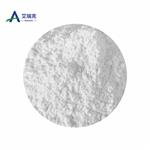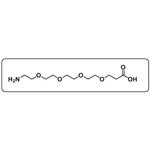Amino-PEG4-acid is a very popular PEG linker. The amino group (NH2) is reactive with carboxylic acids, activated NHS esters, carbonyls (ketone, aldehyde) etc. The terminal carboxylic acid can react with primary amine groups of activated NHS ester to form a stable amide bond, long PEG spacer increases reagent's solubility in aqueous media.
H2N-Dpeg(4)-COOH, can be used in optical imaging of integrin αvβ3 expression with near-infrared fluorescent RGD dimer with tetra(ethylene glycol) linkers. Integrin αvβ3 plays great roles in tumor angiogenesis, invasion, and metastasis.
Amino-dPEG4-acid has a primary amine and propionic acid terminating opposite ends of a 16-atoms long (18.0 ?) polyethylene glycol (PEG) spacer. The single molecular weight PEG spacer is discrete (D = 1). Moreover, it is highly hydrophilic, and it imparts hydrophilicity to conjugates that incorporate it. Amino-dPEG4-acid is useful in many different applications, including peptide synthesis, surface modification, dendrimer construction, and small molecule modification.
reaction type: Pegylations
1. Improving tumor-targeting capability and pharmacokinetics of (99m)Tc-labeled cyclic RGD dimers with PEG(4) linkers. DOI:
10.1021/mp800150r2. Short PEG-linkers improve the performance of targeted, activatable monoclonal antibody-indocyanine green optical imaging probes. DOI:
10.1021/bc400050k3. Microwave-mediated synthesis of labeled nucleotides with utility in the synthesis of DNA probes. DOI:
10.1021/bc100013b4. Improving tumor uptake and pharmacokinetics of (64)Cu-labeled cyclic RGD peptide dimers with Gly(3) and PEG(4) linkers. DOI:
10.1021/bc800455p



